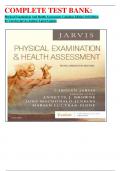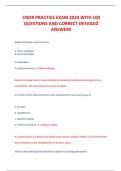COMPLETE TEST BANK:
Physical Examination And Health Assessment: Canadian Edition 3rd Edition
By Carolyn Jarvis (Author) Latest Update.
,Physical Examination And Health Assessment Canadian 3rd Edition
Jarvis Test Bank
Chapter 01: Evidence-Based Assessment
Jarvis: Physical Examination & Health Assessment, 3rd Canadian Edition
Multiple Choice
1. After Completing An Initial Assessment Of A Patient, The Nurse Has Charted That His
RespirationsAre 18 Breaths Per Minute And His Pulse Is 58 Beats Per Minute. These Types
Of Data Would Be:
a. Objective
b. Reflective
c. Subjective
d. Introspective
Ans: A
Objective Data Are What The Health Professional Observes By Inspecting, Percussing,
Palpating,And Auscultating During The Physical Examination. Subjective Data Are What
The Person Says About Himself Or Herself During History Taking. The Terms Reflective And
Introspective Are Not Used To Describe Data.
Dif: Cognitive Level: Understanding (Comprehension)
Msc: Client Needs: Safe And Effective Care Environment: Management Of Care
2. A Patient Tells The Nurse That He Is Very Nervous, Is Nauseated, And “Feels Hot.” These
Types OfData Would Be:
a. Objective
b. Reflective
c. Subjective
d. Introspective
Ans: C
Subjective Data Are What The Person Says About Himself Or Herself During History
Taking. Objective Data Are What The Health Professional Observes By Inspecting,
Percussing, Palpating,And Auscultating During The Physical Examination. The Terms
Reflective And Introspective Are Not Used To Describe Data.
Dif: Cognitive Level: Understanding (Comprehension)
Msc: Client Needs: Safe And Effective Care Environment: Management Of Care
3. The Patient’s Record, Laboratory Studies, Objective Data, And Subjective Data Combine
To FormThe:
a. Database
b. Admitting Data
c. Financial Statement
d. Discharge Summary
,Ans: A
Together With The Patient’s Record And Laboratory Studies, The Objective And
Subjective Data Form The Database. The Other Items Are Not Part Of The Patient’s
Record, Laboratory Studies, OrData.
, Dif: Cognitive Level: Remembering (Knowledge)
Msc: Client Needs: Safe And Effective Care Environment: Management Of Care
4. When Listening To A Patient’s Breath Sounds, The Nurse Is Unsure Of A Sound That Is
Heard. TheNurse’s Next Action Should Be To:
a. Immediately Notify The Patient’s Physician.
b. Document The Sound Exactly As It Was Heard.
c. Validate The Data By Asking A Coworker To Listen To The Breath Sounds.
d. Assess Again In 20 Minutes To Note Whether The Sound Is Still Present.
Ans: C
When Unsure Of A Sound Heard While Listening To A Patient’s Breath Sounds, The Nurse
Validates The Data To Ensure Accuracy. If The Nurse Has Less Experience In An Area,
Then He Or She Asks An Expert To Listen.
Dif: Cognitive Level: Analyzing (Analysis)
Msc: Client Needs: Safe And Effective Care Environment: Management Of Care
5. The Nurse Is Conducting A Class For New Graduate Nurses. During The Teaching
Session, The Nurse Should Keep In Mind That Novice Nurses, With Less Experience,
Are More Likely To BaseTheir Decisions On:
a. Intuition
b. Clear-Cut Rules
c. Articles In Journals
d. Advice From Supervisors
Ans: B
Novice Nurses Operate From A Set Of Defined, Structured Rules. Expert Practitioners Use
CriticalThinking And Their Substantial Background Of Experiences.
u s n t o
Dif: Cognitive Level: Understanding (Comprehension) Msc: Client Needs: General
6. Expert Nurses Assess And Make Decisions Through The Use Of:
a. Critical Thinking
b. The Nursing Process
c. Clinical Knowledge
d. Diagnostic Reasoning
Ans: A
Critical Thinking Is A Multidimensional, Dynamic, And Interactive Thinking Process By Which
Expert Nurses Assess And Make Decisions In The Clinical Area.
Dif: Cognitive Level: Understanding (Comprehension) Msc: Client Needs: General
7. The Nurse Is Reviewing Information About Evidence-Informed Practice (Eip). Which
Statement
Best Reflects Eip?
a. Eip Relies On Tradition For Support Of Best Practices.
b. Eip Is Simply The Use Of Best Practice Techniques For The Treatment Of Patients.
c. Eip Emphasizes The Use Of Best And Most Appropriate Evidence With
ClinicianExpertise And Patient Preference.
d. The Patient’s Own Preferences Are Not Important In Eip.





